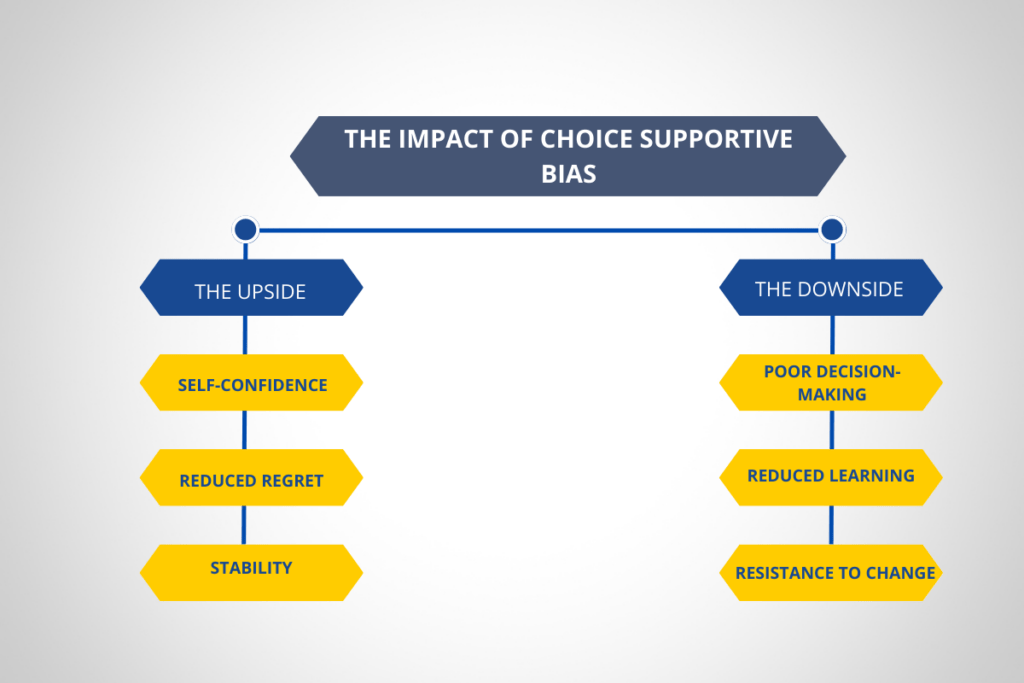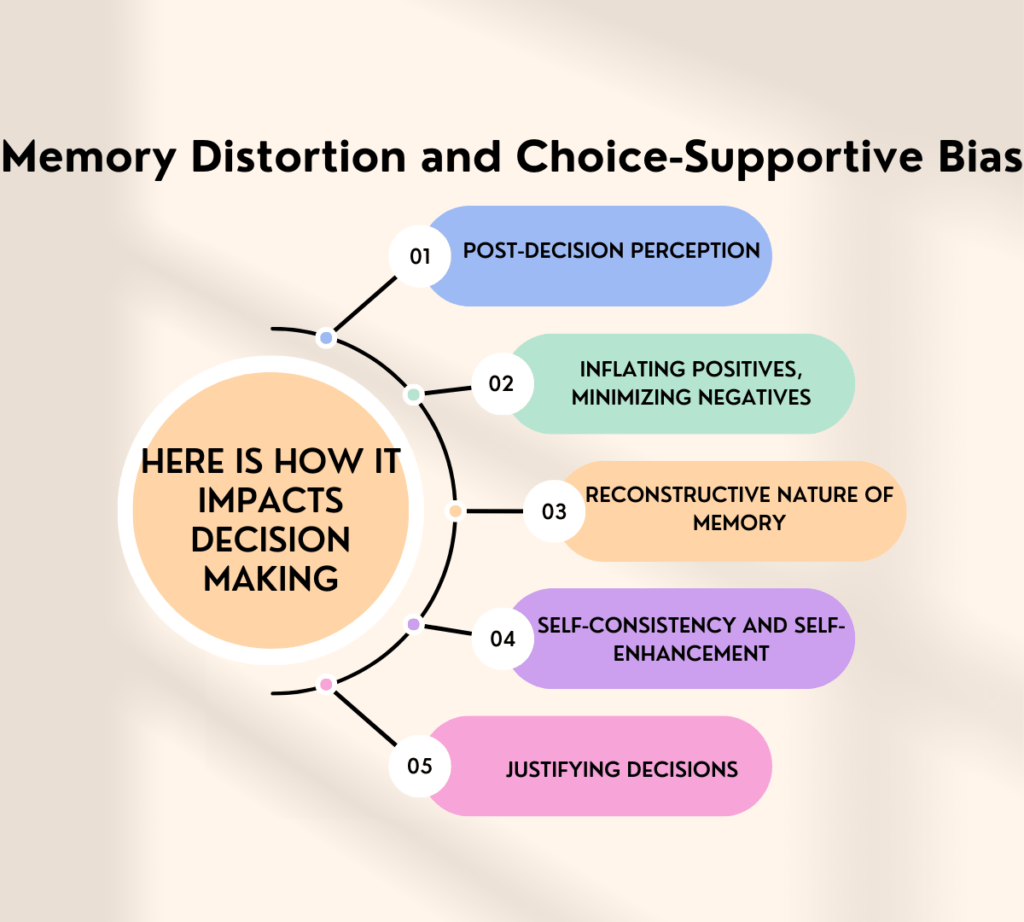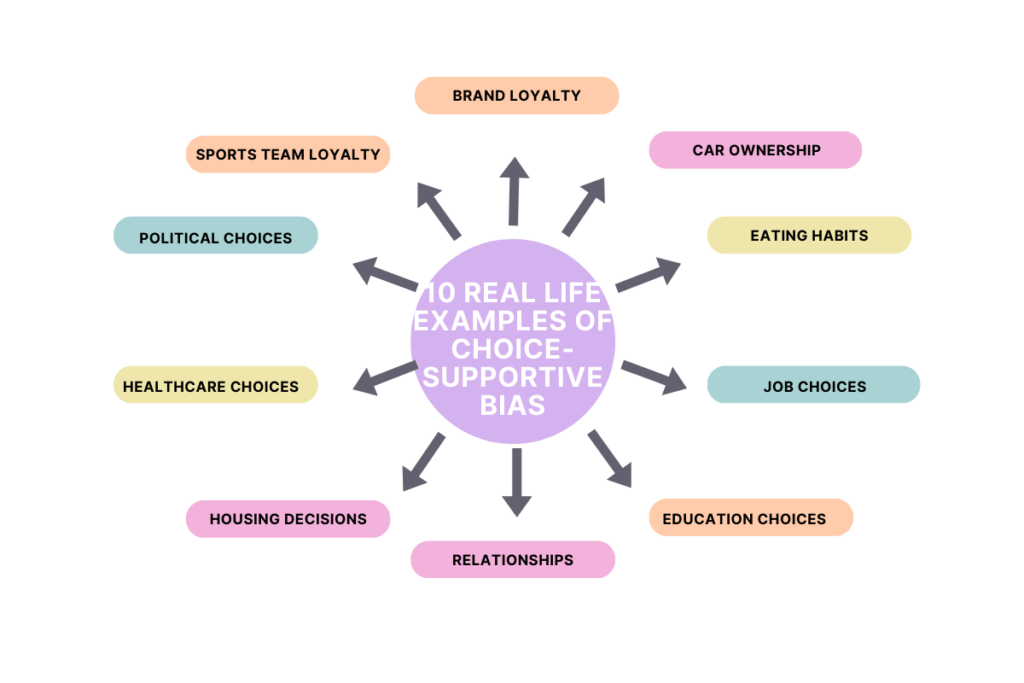Introduction to Choice-Supportive Bias
Choice-Supportive Bias: Have you ever found yourself making a decision and then, even in the face of clear evidence suggesting it may not have been the best choice, still feeling that you made the right call? If so, you’ve experienced something known as Choice-Supportive Bias. This psychological phenomenon is a type of cognitive bias that can subtly, yet significantly, influence our memory and decision-making processes.
Choice-Supportive Bias occurs when we recall a past decision or choice more favorably than it actually was, tending to remember the positive aspects more clearly and dismissing the negative ones. This distortion of memory often results in us justifying our decisions retrospectively, which in turn reinforces our belief that our choices were correct.
This bias affects not just our personal lives but can also have implications in areas like consumer behavior, political choices, and personal relationships. It may make us stick to a particular brand, vehemently defend our chosen political candidates, or gloss over the flaws in our loved ones.
As you read further, you’ll discover more about the fascinating world of Choice-Supportive Bias – how it works, the psychology behind it, how it impacts us, and how we can mitigate its effects for more rational and informed decision-making.
We have written about 125 most common biases and fallacies. Read here
10 Real Life Examples of Choice-Supportive Bias

Brand Loyalty: Even when a competing product might be better or cheaper, we may stick to a brand we have always used because we remember our past experiences with the brand more positively.
Car Ownership: People often justify their choice of car by focusing on the good features (like speed, comfort) and downplaying the negative aspects (like fuel efficiency, high maintenance costs).
Eating Habits: We might continue eating unhealthy foods, remembering the taste and pleasure it provides while ignoring the negative health effects.
Job Choices: People often remember the positive aspects of their job (good salary, friendly colleagues) while overlooking the negatives (long hours, high stress) to justify their decision to stay.
Education Choices: We may justify our choice of university or field of study by emphasizing the good aspects and downplaying the bad, even in light of contrary evidence or outcomes.
Relationships: We often remember the positive aspects of our partners and ignore their shortcomings, thereby justifying our choice to stay in the relationship.
Housing Decisions: Homeowners may emphasize the positive aspects of their house (location, view, neighbors) while downplaying the negatives (high mortgage, maintenance issues) to feel good about their choice.
Healthcare Choices: Patients may overlook the side effects of a treatment or medication, focusing only on its benefits, thereby justifying their choice.
Political Choices: Voters often remember their chosen candidate’s achievements and downplay their shortcomings, which further supports their decision to vote for them.
Sports Team Loyalty: Fans may justify their loyalty to a particular sports team, highlighting the team’s successes and overlooking their failures.
We have written about 125 most common biases and fallacies. Read here
Psychology Behind Choice Supportive Bias
Choice-Supportive Bias falls under the umbrella of cognitive biases, which are systematic errors in thinking that can influence the decisions and judgments that people make. It’s an intriguing psychological concept that impacts how we view our past decisions and choices.
The primary mechanism through which Choice-Supportive Bias operates is memory distortion. Memory isn’t an exact recording of our past, but rather, a reconstruction influenced by various factors. One of these factors is our desire to view ourselves in a positive light, often referred to as self-enhancement. We want to believe that we make good decisions, and this can lead to distorted recall, where we remember our past choices as being better than they actually were.
Here’s the interesting part – when we make a decision, it often involves weighing up different attributes. For example, when buying a car, you might consider aspects such as cost, fuel efficiency, comfort, and design. Post-decision, due to Choice-Supportive Bias, we tend to inflate the importance of the attributes that favored our chosen option and downplay those that didn’t. So, you might end up recalling your chosen car as being more cost-effective and comfortable than it actually is.
Furthermore, Choice-Supportive Bias is tied in with the concept of cognitive dissonance – the mental discomfort that comes from holding two contradictory beliefs, or behaving in a way that contradicts our beliefs. To ease this discomfort, we might justify our decisions or actions in a way that aligns them with our self-image.
For instance, if you bought an expensive, non-environmentally friendly car while considering yourself budget-conscious and environmentally friendly, you might feel cognitive dissonance. To ease this discomfort, you might exaggerate the positive aspects of the car (e.g., its comfort or design) and downplay the negative ones (cost, environmental impact), thus aligning the decision with your self-image.
We have written about 125 most common biases and fallacies. Read here
The Impact of Choice Supportive Bias
Choice-Supportive Bias can have various impacts on our lives, affecting both our decision-making and how we perceive ourselves. There are both positives and negatives associated with this bias.

The Upside
Self-Confidence: By remembering our past decisions as better than they were, Choice-Supportive Bias can boost our self-confidence and enhance our self-esteem. This could lead to increased confidence in future decision-making.
Reduced Regret: This bias can help minimize feelings of regret. By seeing our past choices in a positive light, we’re less likely to feel regret over the decisions we’ve made.
Stability: Choice-Supportive Bias can lead to stability in our choices and behavior. It helps us stick to our decisions, providing consistency in our lives.
The Downside
Poor Decision-Making: Choice-Supportive Bias can distort our decision-making process, leading us to make less optimal choices. By emphasizing the positive aspects of our past decisions, we may overlook better alternatives.
Reduced Learning: This bias can hinder our ability to learn from our mistakes. If we always view our decisions positively, we may fail to recognize and learn from the errors we’ve made.
Resistance to Change: Since Choice-Supportive Bias can make us stick to our past decisions, it might create resistance to change, making it hard for us to adapt to new situations or information.
We have written about 125 most common biases and fallacies. Read here
Overcoming Choice Supportive Bias
Raise Self-Awareness: Understanding and acknowledging that we have a tendency to distort our memories in favor of our past decisions is the first step towards overcoming this bias. Self-awareness allows us to critically evaluate our choices and see them in a more balanced light.
Seek External Input: Our personal biases can often blind us to certain aspects of our decisions. Seeking feedback or different perspectives from others can help provide a more objective view of our choices. Others might notice things that we’ve overlooked, helping to counteract our natural bias.
Record Decision-Making Processes: Keeping a journal of your decision-making process, along with the pros and cons you considered, can serve as a more objective record. When you look back, you’ll have a realistic account of what factors influenced your decision, which can help correct any memory distortions.
Practice Mindfulness: Mindfulness involves staying present and consciously thinking about our actions and decisions. By practicing mindfulness, we can become more aware of when we might be distorting our memories or choices and take steps to correct it.
Embrace Uncertainty and Mistakes: Accept that it’s okay to make mistakes. Nobody makes perfect decisions all the time. Each mistake is a learning opportunity. By viewing mistakes in this way, we reduce the need to always see our decisions as being better than they were.
Memory Distortion and Choice-Supportive Bias

Post-Decision Perception: After making a decision, we’re prone to remembering it more positively than it may have been. This distortion of memory serves to affirm our choice, thereby reducing potential regret or cognitive dissonance we might experience. This is the essence of Choice-Supportive Bias.
Inflating Positives, Minimizing Negatives: To make our decisions seem better, our memory may inflate the positive aspects of our choice and minimize or even forget the negatives. For instance, if you bought a car and later discovered it has poor fuel efficiency, you might remember its comfortable seats and sleek design while downplaying or forgetting about the high fuel costs.
Reconstructive Nature of Memory: Memory isn’t a perfect playback of events. It’s reconstructive, meaning we build memories from pieces of information available, sometimes filling in gaps with our expectations or beliefs. When it comes to our choices, this reconstructive nature of memory can lead to distorted recall, favoring our decisions.
Self-Consistency and Self-Enhancement: We like to view ourselves consistently and favorably. To maintain a positive self-image, we might distort our memories to align our past decisions with our present self-concept, making our choices seem wiser or more prescient than they actually were.
Justifying Decisions: The distortion of memory related to Choice-Supportive Bias often serves to justify our decisions. We remember our choices as better than they were to validate them and make us feel confident about our decision-making abilities
We have written about 125 most common biases and fallacies. Read here
Samrat is a Delhi-based MBA from the Indian Institute of Management. He is a Strategy, AI, and Marketing Enthusiast and passionately writes about core and emerging topics in Management studies. Reach out to his LinkedIn for a discussion or follow his Quora Page

